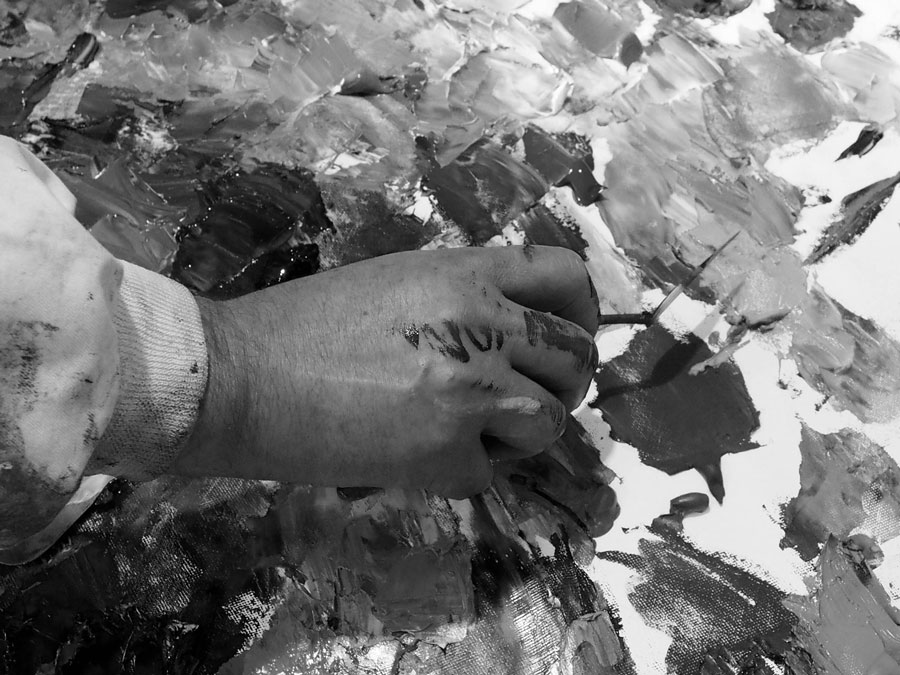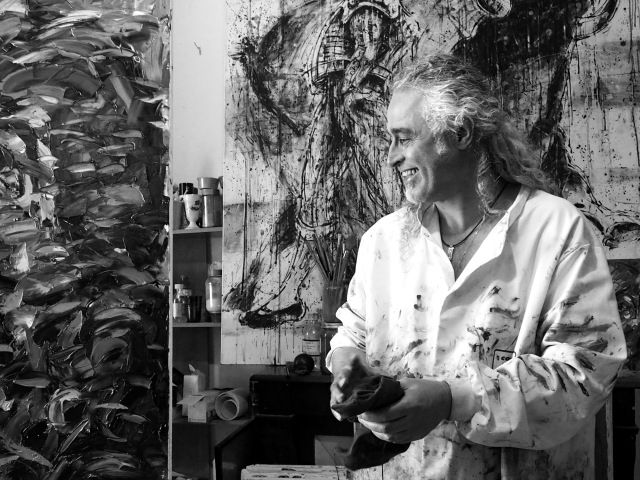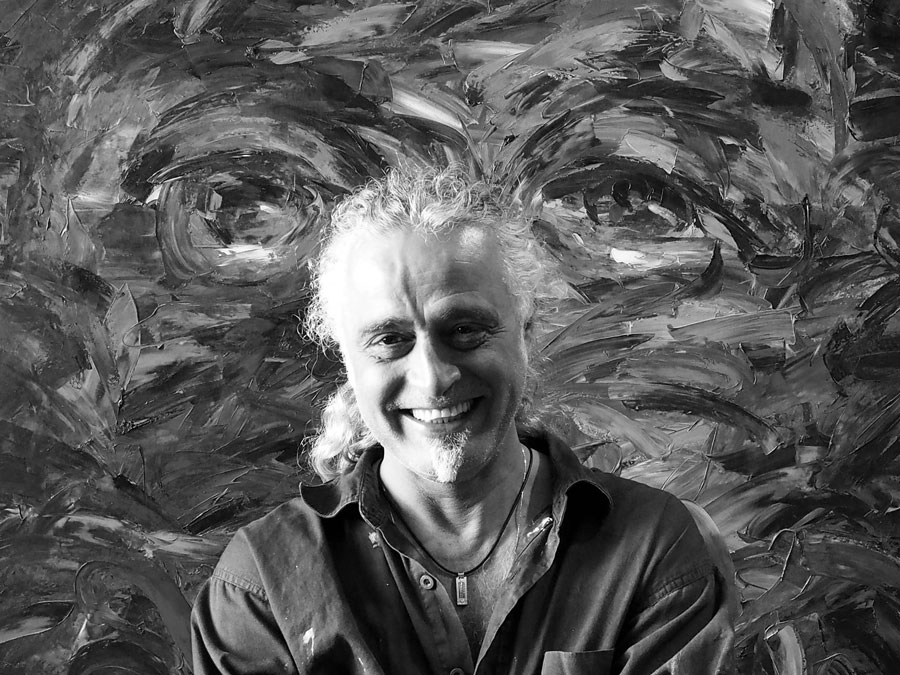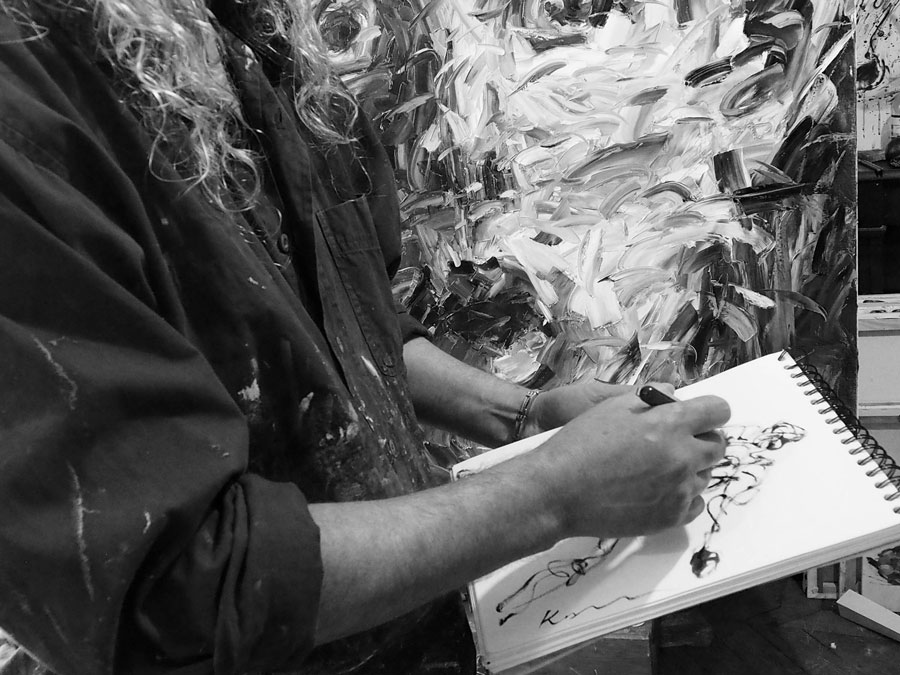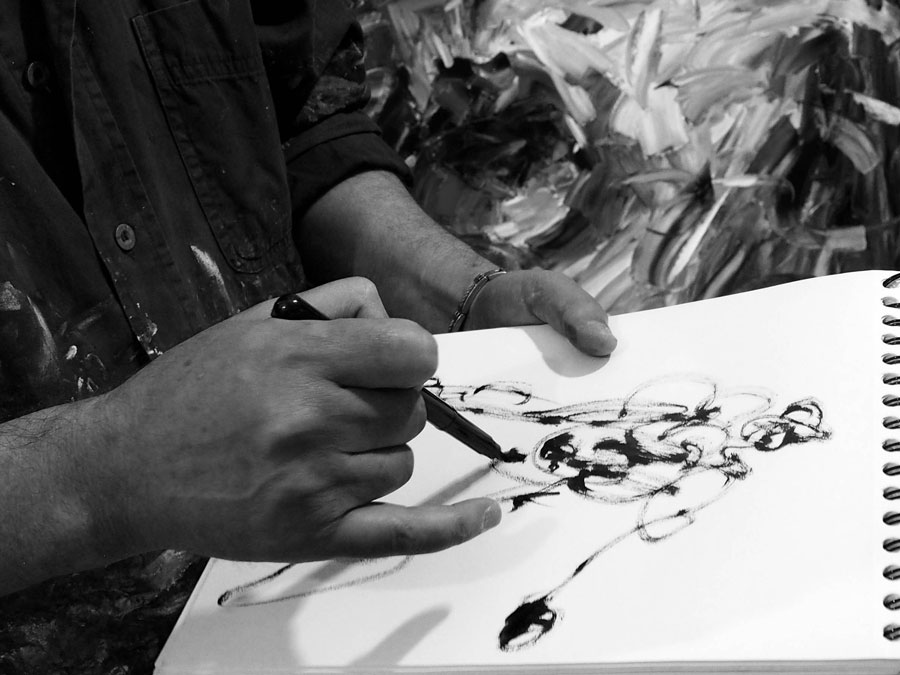Source de l’article : CREATIVE HAVENS : SYRIAN ARTISTS AND THEIR STUDIOS
Khazem Khalil, a leading visual artist and sculptor.
A Syrian native, born in Latakia, Syria.
Currently residing in Paris, France.
What is your relationship to your studio? What does your studio represent to you? How do you feel when you are in your studio?
Can we really talk about a relationship? It is more like containment, like one of us is a foetus inside the other; it is a real and complete intimacy where scribbles can draw the material and spiritual history. The studio is the secret laboratory of the chemistry of colours; I would even say the chemistry of death, of life, and of the body, where materials get mixed with memory, with all senses and thoughts, inside this uterus producing foetus, in order to give birth to ideas and feelings. The materials I use in my studio become a part of my body like a respiratory or circulatory system, a system organising the vision and the intensity of images in my mind.
Gustave Courbet said: “It is like the world is coming to draw itself in my place…”, so if artists have to start discovering the world, we have at first to find the witness of senses in the experimental process because it creates a universe with a substantial aspect. The sacred internal world is associated to the experimental, intellectual and visual heritage, as well as to the outside material and physical worlds. On the way of discovering the secrets of nature and materials, beautiful things happen in the studio. This wonderful intimate dialogue between the artist and the material create the visual appearance, and will be the base and the core of creation. The material becomes the messenger to explain the enigma of the artist’s thoughts; and here the visualisation builds the relationship with the mind and the soul in order to create symbols and signs, thus the material is transformed chemically and physically in an expression bringing us to make another kind of relationship with the world.
In the studio we are in a laboratory, and because we do not know where colours, materials and ideas will bring us to, it is a game offering the suspense of discovering, and the pleasure of transforming the materials; here we discover the relationship between the origins and the results, it is the art of owning the movement.
When I enter this intimate and secret place, I take off everything, but my childhood and my memories; I will become nude, yet wearing the love of creation, the seduction of a white space. When I draw I make love to my painting. It is a place where the only good thing to do is to yield to temptation. In the studio I practice my traditions, I am truly myself, I accept my devil’s nature, or in the best case my nature as a corrupted angel.
Do the layout, the organization and the location of your studio have an influence on the creation of your works? What role do that space, time and solitude have on your work?
I always try to be organised, but when I start to work everything fall apart then, and when I finish the work, I become aware that this disorder reflects my own image, it looks like me! It seems like this disorder is the equivalent of my pulsation, my anxiety and my breath, a part of me. Colours, instruments, and materials regulate my heartbeat upon the map of my own world, fly everywhere to draw my image, my body, and to limit my movements. My disorder is coming from my inner world where no gravity exists.
This small world in my studio is 30 minutes walking from my home. On this way between them two I can see my Syrian village “Bisnada”, a dusty way close to a small river where I can remember Kazem the child growing up with reeds around the river… and then nostalgia occupies the whole space of my soul. It is the necessary distance to tame myself and my memories between the quotidian life and my artistic haven. When I arrive I find in my studio a huge world full of possibilities for drawing and sculpting… for creating!
The fact that my workshop is situated inside a forest and close to a beautiful small river helps me to live fully my artistic loneliness.
Do you listen to music in your studio? Do you work better with some music in your ear or do you need complete silence when you are at your most creative?
No, I don’t! When I listen to music it penetrates unconsciously my deeper self. So does it too for my work, and I would then be alike a translator of music into painting. Music is like other arts, especially painting has bases of harmony, rhythms, and construction, so introducing music into another creative process may not allow me to remain neuter; I prefer not to transform music into visual works.
I listen to music, but always before and after painting or sculpting. Some music is provocateur, another invites me to work, and even to dance, some music captives me, that is why I prefer listening to the silence in my studio. My workshop is set in the nature; I prefer to feel fully this wild place, and to hear the sounds of nature, the wind, the rain, and the songs of the trees. All of this gives me a feeling of freedom.
What are your artistic practice and your working process? Do you plan?
Actually, there is always a project about a special subject. I use to plan, to search for references and to visit museums, and for the accomplishment of the project I make between 40 and 60 paintings. All this work gets the same bases, a body, a movement, and a portrait in colour or in black and white, even a sculpture sometimes.
So I work around an idea since the beginning. My memory starts to fill up the project, then painting arrives, different and various. I work on it spontaneously, without ever being critical with myself or attempting to control the artistic process to 100%. I think controlling totally the process of creating is a non-moral act, because, more than painting, the artistic project is a creature, it is alive; I have a kind of conversation with it, and a lot of beautiful details come spontaneously. Globally those spontaneous details become, after a while, the special touch of the artist, even if it is involuntary. Finally the painting shows the artist his way to finish it.
What your art is about?
I am always wondering: can I express human feelings? Can I explain in my art our historical period? With each painting done I do ask myself: does this work express the feelings, emotions and pains of people?. All what I want is to be somehow the conscience of those people, their voice, the echo of their emotions.
Do you ever regret becoming an artist? Where does your energy come from?
Who can regret to be a professional artist? It would be so naive to say I would! I only regret when I have to spend a day without being able to paint or sculpt. I left my city and my village, I left my studies as an electric engineer, and I used to feel that special energy that will be attracting me until death. This energy did not let me be like others, think like others, or see my future like others, as an engineer or a teacher… this energy took me much further than my own dreams.
I could not resist to this energy; I was constrained to follow it, to fly with it and cross the sea to arrive to Europe. Here in Paris where I live and work, there are thousands of artists, thus I had to become an artist holding his cross trough the mountain.
How much satisfaction do you get in response of your work?
I may say that I am globally satisfied with myself, yet till now I could not say that I am satisfied with my artistic production, because when I finish each work I always feel that there are still a lot of things I did not say or express. So there always will be a future work more beautiful than the previous one.
I am satisfied with myself but… I am satisfied with my efforts but… I still have an ambition to do what I think would even be better. The good thing in this state of mind is that I still have a child’s eyes able to be surprised; I still have the energy to be surprised and to surprise others. So the day when I might be totally satisfied with my work, I might be in hell, then.
Photo and video credit © Khaled Youssef
